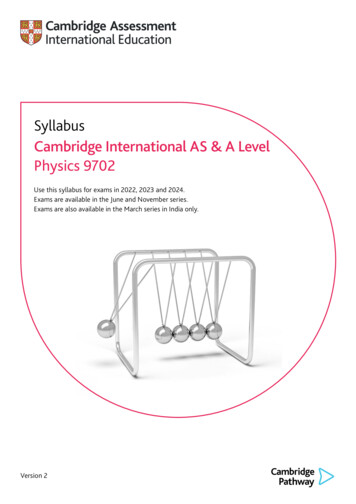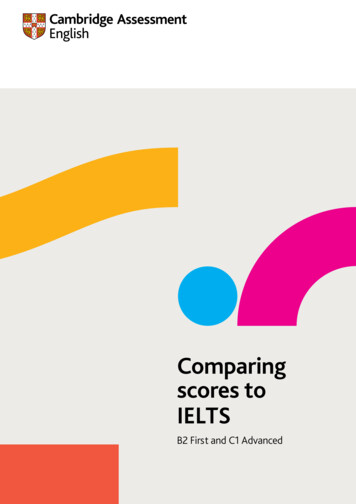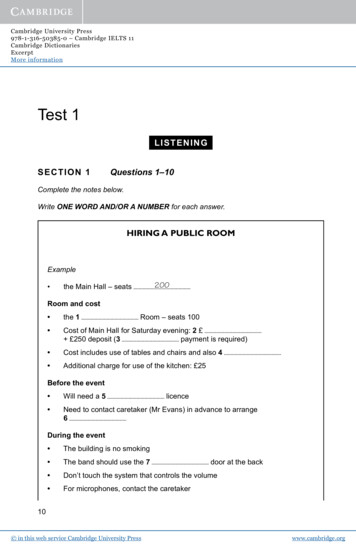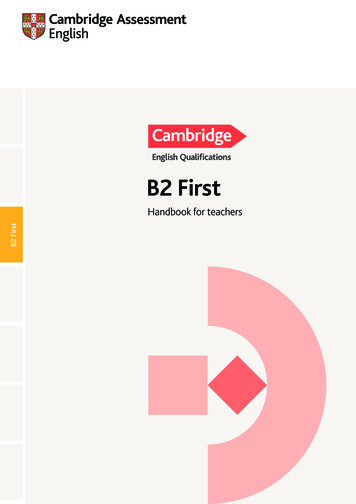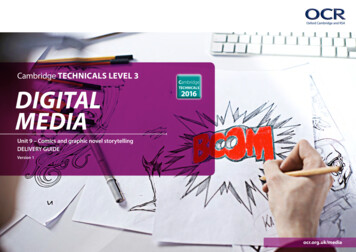
Transcription
Cambridge TECHNICALS LEVEL 3DIGITALMEDIAUnit 9 – Comics and graphic novel storytellingDELIVERY GUIDEVersion 1ocr.org.uk/media
CAMBRIDGE TECHNICALS IN DIGITAL MEDIACONTENTSIntroduction3Related Activities4Key Terms5Misconceptions7Suggested Activities:Learning Outcome (LO1)8Learning Outcome (LO2)12Learning Outcome (LO3)17Learning Outcome (LO4)19LEVEL 3 UNIT 92
CAMBRIDGE TECHNICALS IN DIGITAL MEDIAINTRODUCTIONThis Delivery Guide has been developed to provide practitioners with a variety ofcreative and practical ideas to support the delivery of this qualification. The Guideis a collection of lesson ideas with associated activities, which you may find helpfulas you plan your lessons.OCR has collaborated with current practitioners to ensure that the ideas put forward inthis Delivery Guide are practical, realistic and dynamic. The Guide is structured by learningoutcome so you can see how each activity helps you cover the requirements of this unit.We appreciate that practitioners are knowledgeable in relation to what works for themand their learners. Therefore, the resources we have produced should not restrict orimpact on practitioners’ creativity to deliver excellent learning opportunities.Whether you are an experienced practitioner or new to the sector, we hope you findsomething in this guide which will help you to deliver excellent learning opportunities.If you have any feedback on this Delivery Guide or suggestions for other resources youwould like OCR to develop, please email resources.feedback@ocr.org.uk.OPPORTUNITIES FOR ENGLISH ANDMATHS SKILLS DEVELOPMENT AND WORKEXPERIENCEWe believe that being able to make good progress in English and maths is essential tolearners in both of these contexts and on a range of learning programmes. To help youenable your learners to progress in these subjects, we have signposted opportunities forEnglish and maths skills practice within this resource. We have also identified any potentialwork experience opportunities within the activities. These suggestions are for guidanceonly. They are not designed to replace your own subject knowledge and expertise indeciding what is most appropriate for your learners.UNIT AIMComic books and cartoon strips have been around for a very long time from the earliestcave paintings depicting graphic scenes to the digital comics we see today. Comics havedeveloped their own style, characters and following. Comics have served many purposes;firstly to entertain but secondly, in the case of some comics, to purvey a message to thosewho read it.By completing this unit, you will understand the comic and graphic novel world. Youwill understand the content of a graphic novel or comic and how it relates to its targetaudience. You’ll be able to develop one character for an original graphic novel or comic,and plan and produce panels for an original graphic novel or comic for this character.Unit 9 Comics and graphic novel storytellingLO1Know the graphic novels and comics industryLO2Be able to plan the production of an original graphic novel or comicLO3Be able to develop ideas for an original character for a planned storyLO4Be able to produce an original graphic novel or comicTo find out more about this qualification, go to: iteEnglish Maths WorkPlease noteThe activities suggested in this Delivery Guide MUST NOT be used forassessment purposes. The timings for the suggested activities in this DeliveryGuide DO NOT relate to the Guided Learning Hours (GLHs) for each unit.LEVEL 3 UNIT 9Assessment guidance can be found within the Unit document available fromwww.ocr.org.uk. The latest version of this Delivery Guide can be downloaded fromthe OCR website.2016 Suite New suite for first teaching September 2016Externally assessed contentEligible for Key Stage 5 performance points from 2018Designed to meet the DfE technical guidance3
CAMBRIDGE TECHNICALS IN DIGITAL MEDIARELATED ACTIVITIESThe Suggested Activities in this Delivery Guide listed below have also been related to other Cambridge Technicals in Digital Media units/Learning Outcomes (LOs). This could help withdelivery planning and enable learners to cover multiple parts of units.This unit (Unit 9)Title of suggested activityOther units/LOsLO1Contrast between different comicsUnit 7 Journalism and the newsindustryLO2 Analyse the linguistic conventions used within different news articlesGenre, style and purposePanelling and meaningUnit 1 Media products andaudiencesLO4 Understand the target audiences of media productsPlanning - meeting comic book creatorsUnit 9 Comics and graphic novelstorytellingLO3 Be able to develop ideas for an original character for a planned storyPlanning – the comicUnit 2 Pre-production and planningLO1 Understand the factors that need to be considered during the planning of a mediaproductUnit 9 Comics and graphic novelstorytellingLO1 Know the graphic novel and comics industryPlanning – legalUnit 1 Media products andaudiencesLO6 Be able to evaluate legal, ethical and regulatory issues associated with media productsPlanning – panelsUnit 2 Pre-production and planningLO3 Be able to plan the pre-production of a media productUnit 9 Comics and graphic novelstorytellingLO1 Know the graphic novel and comics industryUnit 2 Pre-production and planningLO3 Be able to plan the pre-production of a media productUnit 22 Scripting for media productsLO2 Be able to generate ideas and plan the script for a media product, in response to aclient briefIndustry standard production methodsUnit 9 Comics and graphic novelstorytellingLO2 Be able to plan the production of an original graphic novel or comicCharacter sketches, drawingsUnit 13 Graphic design for digitalmedia productsLO2 Be able to generate conceptual ideas and plan graphic design items in response to aclient briefGenerating ideasUnit 2 Pre-production and planningLO4 Be able to create and evaluate pre-production documents for a new media productUnit 9 Comics and graphic novelstorytellingLO1 Know the graphic novels and comic industryLO2 Be able to plan the production of an original graphic novel or comicDrawings and illustrationsUnit 9 Comics and graphic novelstorytellingLO1 Know the graphic novels and comic industryPlan the feel of a new comic storyUnit 13 Graphic design for digitalmedia productsLO2 Be able to generate conceptual ideas and plan graphic design items in response to aclient briefProduction – layoutProduction – story and dialogueUnit 9 Comics and graphic novelstorytellingLO1 Know the graphic novels and comic industryLO2 Be able to plan the production of an original graphic novel or comicLO2Inside the panelsLO3LO4LEVEL 3 UNIT 94
CAMBRIDGE TECHNICALS IN DIGITAL MEDIAKEY TERMSExplanations of the key terms used within this unit, in the context of this unitLEVEL 3 UNIT 9Key termExplanationBackstoryThe story that precedes that particular comic; so for example within Spiderman there is a backstory to how he gained his powers and what motivates him.Character traitsWhat drives and motivates the character and how they express this; for example Captain America is patriotic and protects the weak.CopyrightCopyright applies to work that is recorded in some way; rights exist in items such as literary, artistic, musical and dramatic work as well as films, sound recordingsand typographical arrangements. It gives the author specific rights in relation to the work, prohibits unauthorised actions, and allows the author to take legalaction against instances of infringement or plagiarism.ColouristsA colourist is responsible for adding colour to black-and-white line art. For most of the 20th century this was done using brushes and dyes which were then usedas guides to produce the printing plates. Since the late 20th century it is most often done using digital media, with printing separations produced electronically.CroppingTo cut an image down to a required size to remove unwanted items from the image.DenotationWhat the audience can visually see on a page. For example in The Wizard of Oz, Dorothy talks about there being no place like home; if we take the denotation thenby ‘home’ she means Kansas.Digital comicsLike the graphic novel the digital comic is an extension of the comic, but rather than being paper based it is online or downloadable. With the advent of the tabletor e-reader this medium is becoming more popular. Within the digital comic it is possible to click on a panel to enlarge it.GenreA genre is a specific type of comic; this may be science fiction, horror, romance etc.Graphic novelsRather than a traditional novel with words on the page a graphic novel uses images as well as text to portray the story.IconographyIconography is pictorial material relating to or illustrating a subject; for example the Joker with green hair, white face, red grin.InkersUsing a pen or a brush, the inker adds depth and shading to give the image more definition. Only then does the image take shape.Intellectualproperty rightsIntellectual property is something unique that you physically create. An idea alone is not intellectual property. For example, an idea for a book doesn’t count, butthe words you’ve written do.LetterersA letterer is a member of a team of comic book creators responsible for drawing the comic book’s text. The letterer’s use of typefaces, calligraphy, letter size, andlayout all contribute to the impact of the comic. For example in early Batman comics the use of ‘POW!’ when hitting a villain.LibelLibel is the written or broadcast form of defamation that can be proved not to be true. Libel is a method of defamation expressed by print, writing, pictures, signs,effigies, or any communication embodied in physical form that is injurious to a person’s reputation, exposes a person to public hatred, contempt or ridicule, orinjures a person in his/her business or profession.MangaManga comics are created in Japan, or by creators in the Japanese language. They are in a style developed in Japan in the late 19th century.Mood boardA mood board is an arrangement of materials, images, pieces of text, etc that are intended to evoke or project a particular style or concept. If a mood board wasbeing constructed for Batman then it would have dark colours and a ‘gothic’ feel.Motion comicsA motion comic (or animated comic) is a form of animation combining elements of print comic books and animation. Individual panels are expanded into a fullshot while sound effects, voice acting, and animation are added to the original artwork. Text boxes and sound effect bubbles are typically removed to feature moreof the original artwork being animated.NarrativeWithin a comic, a story that is a written account of connected events.PanellingThe boxes that are on the pages of the comic in which the characters appear. Panels are laid out to enable the story to flow. This can range from a basic lineardesign to a more complex layout using for example a central panel with other panels around it.5
CAMBRIDGE TECHNICALS IN DIGITAL MEDIAExplanations of the key terms used within this unit, in the context of this unitKey termExplanationPencillersA penciller is an artist who works in the creation of comic books, graphic novels, and similar visual art forms. In the American comic book industry, the penciller isthe first step in rendering the story in visual form, and may require several steps of feedback with the writer. Jack Kirby was one of the more famous pencillers inthe comic book world.ReadabilityA comic must ensure that the storyline can be easily read by its target audience so it is important that reading age is taken into account and age appropriatelanguage is used. The age can be well judged by using the likes of Flesch reading-ease and Flesch-Kincaid tools in software.RoyaltiesA sum paid to a patentee for the use of a patent or to an author or composer for each copy of a book sold or for each public performance of a work. Thus if acomic gets turned into a successful film or game then the royalties could also come from this.Self-publishingWith the onset of tablets and online content it is becoming easier for comic book creators to self-publish their own work. At comic cons there are many selfpublishing comic book creators.SemioticsHow meaning is created or communicated.SlanderOral defamation, in which someone tells one or more persons an untruth about another which will harm the reputation of the person defamed.StructureA comic will often, the same as a traditional novel, contain a three-act structure. The first act is the beginning or setting up of the context, the second act is themiddle where characters attempt to achieve goals and encounter conflict, the third act or the end is where there is a resolution to the conflict. Sometimes thestory ends with a ‘cliffhanger’ and the resolution is not given at the end of that comic.SynopsisAn outline of the plot in a comic.LEVEL 3 UNIT 96
CAMBRIDGE TECHNICALS IN DIGITAL MEDIAMISCONCEPTIONSSome common misconceptions and guidance on how they could be overcomeWhat is the misconception?How can this be overcome?Resources which could helpConfusion and overlap betweenfilms and associated comicsComic books could be made available to learners for research, for them toA selection of comic books including those not made intounderstand the storyline and narrative of the comic rather than the film. Reference film.to the film versions should be avoided as much as possible; even though learnersmay well have seen the films they should be advised to disregard them (eventhough some are fairly true to the original storyline).How to ensure that the comic issuitable for the target audienceExplain how violence, horror and language used within the comic must besuitable for the scenario or in line with the age group sources.com/?page article&id e-marvelrating-system.htmlHow to show why comics arepopularThere should be an explanation of reader engagement. Just because thelearner likes the concept it does not necessarily mean others will; it may be thatresearching within the centre the sort of comics that are popular will give anindication as to reader m/why-comicsLEVEL 3 UNIT 97
CAMBRIDGE TECHNICALS IN DIGITAL MEDIASUGGESTED ACTIVITIESLO No:1LO Title:Know the graphic novels and comics industryTitle of suggested activitySuggested activitiesContrast between differentcomicsTutors could arrange a selection of comic books that are from different writers/pencillers. Learners2 hourscould be divided into smaller groups and each of these groups could look at two contrasting comicsfrom among titles such as The Incredible Hulk, Hercules, Iron Man, Astonishing X-Men, Superman, Batman,Judge Dredd, The Beano, The Dandy and report back to the rest of the class on their findings as to howthese are different depending on the hero and writer.Suggested timingsAlso related toUnit 7 LO2Learners could also look at e-comics and how the comic industry is catering for tablet users and howthe medium has been adapted to e-readers and the screen sizes and resolutions.Below are some useful links for online comics that give an insight into the world of comics and howthe comic book genre may develop in the lhttp://www.acomics.com/best1.htmComic titles and writershistoricallyFollowing on from the activity above, tutors could give the same titles to the group but arrangedinto different eras and writers to show how the comic itself has changed. Possible writers, pencillers,letterers, inkers, colourists could include: Stan Lee Jack Kirby Bob Kane Will Eisner Osamu Tezuka Kev F Sutherland Alan Moore.2 hoursLearners could compose an online blog to show their findings that others could then add to andaccess across the group.LEVEL 3 UNIT 9The following links provide a brief history of t.com/od/historyofmanga/8
CAMBRIDGE TECHNICALS IN DIGITAL MEDIATitle of suggested activitySuggested activitiesSuggested timingsCompaniesThe group could be split into smaller groups to research different companies that produce comics(such as DC Comics, Manga Entertainment, Marvel Comics, DC Thompson, Fleetway Publications,Image Comics).2 hoursAlso related toIt would be useful for the group to look at comparing the likes of DC, Manga and Marvel againstsome of the lesser known comic book companies like Image Comics and Fleetway (exploring theway Fleetway – then Amalgamated Press – developed its pre-war and post-war humorous comics).Learners could complete a comparison table and share their findings this could be in the format of apresentation to the whole group.The links below gives some information on the history of some of the comic book op-five-comic-book-publishers-biggest-comicsLEVEL 3 UNIT 99
CAMBRIDGE TECHNICALS IN DIGITAL MEDIATitle of suggested activitySuggested activitiesSuggested timingsGenre, style and purposeTutors could lead a discussion looking at the different genres and styles of comics, maybe projecting30 minutessamples onto a board for the group to comment on e.g. Japanese verses American and British stylesof comic. Ideally, tutors should provide a good mix of differing styles from each country and targetaudience. As well as projecting on a board tutors should have a range of printed comics for learners tolook through and review.Also related toUnit 1 LO4Tutors may want to look at the following titles to start with to give a feel for different areas (learnersmay have their own comics and graphic novels that they can bring into the session): Deadpool Judge Dredd The Complete MAUS V for Vendetta Batman: Arkham Death Note Tokyo Ghoul (in contrast to a more traditional ghost story) The Beano Valiant (though this may need to be an annual as the comic may be hard to come by).Learners could look at the type of comic that has been produced e.g. action and adventure, humour,superhero; some of these areas may link into the comics that are outlined above, others may takefurther research.Learners could create a report that reviews the genre, style and purpose using scans or photographicevidence from the comics they have looked at (the photographs could come from the use of asmartphone to capture images from the comics reviewed).The link below looks at 50 different comic book styles of art that may give some discussion as toaudience and purpose of the comic from a brief view of the artwork and L 3 UNIT 910
CAMBRIDGE TECHNICALS IN DIGITAL MEDIATitle of suggested activitySuggested activitiesSuggested timingsAlso related toPanelling and meaningFollowing on from the activity above, tutors could, using samples, explain how the comic book iscreated using panels, text, thought bubbles, text bubbles, box placement etc and how meaningis then created through elements of content and style (e.g. colour, language, text, images, props,costumes), semiotics (e.g. connotation, denotation, signification, iconography, anchorage), andtechniques (e.g. cropping, sizing, use of captions, choice of fonts, angle of the drawn action andcharacters).1 hourUnit 1 LO4Learners could also look at the emerging market for e-comics and how tablets have created thismarketplace and how the comic industry is designing comics for this audience.Using the comics reviewed in the previous activity, learners could create a blog that looks at the use ofpanelling and the elements that make up a single comic page. Other learners in the group could thenreview this and compare it with the areas they have looked at.The following links show how panels can be laid out and the most effective way for m/comics/20-powerful-comic-book-panels-time?page 2Purpose of comic charactersand booksLearners could be split into smaller groups and asked to research backstories for characters such astheir traits, abilities and their relationships with other characters; for example, Peter Parker’s backstorywith his parents (and the crossover with Red Skull), his Aunt May and Uncle Ben and how theseimpact on his life and transformation into a ‘superhero‘, his abilities and how he gained these.1 hourLearners could research how backstories and personalities have developed over time and how theyhave changed to keep their appeal for the target audience. It may be useful for tutors to allow learnersto look at some of the messages comics portrayed during the pre- and post-war periods and how theCold War affected storylines.Learners could then present their findings to the rest of the group.LEVEL 3 UNIT 9The links below provide information on the history of many comics including manga and Britishcomics and how they have changed over www.aischool.org/uploaded/Library/Secondary School/SS Library/General Comic BookProposal no budget.pdf11
CAMBRIDGE TECHNICALS IN DIGITAL MEDIASUGGESTED ACTIVITIESLO No:2LO Title:Be able to plan the production of an original graphic novel or comicTitle of suggested activitySuggested activitiesSuggested timingsAlso related toPlanning – meeting comicbook creatorsIf possible, it could be useful for learners to visit a comic convention. This will allow learners to meetartists and independent comic producers so that they can get ideas and gain an understanding ofhow comics are planned and designed. Often at these conventions, there are many independentcomic producers who may be willing to talk to learners as well as some more well-known comicbook creators. This activity could be linked with the Industry standard production methods activity inLearning Outcome 3.2 hoursUnit 9 LO3It may be useful if learners could video or get friends to video on a smartphone conversations withthe artists and comic book producers that could then be played back to the group on returning to thecentre. Learners could create a diary blog of the activity and what they did.The links below are to companies that arrange comic conventions. Tutors could see if there are anyconventions local to their centre and arrange for learners to visit them (note however that theseare the major companies that arrange them within the UK; there are often smaller local comicconventions that may be advertised in the local com/LEVEL 3 UNIT 912
CAMBRIDGE TECHNICALS IN DIGITAL MEDIATitle of suggested activitySuggested activitiesSuggested timingsAlso related toPlanning – the comicTutors could use the following scenario as a practice brief in order to reinforce skills:You are required to create a comic book for road safety. The target audience is 9–14-year-olds. The comicbook should have a superhero within it who promotes road safety.1 hourUnit 2 LO1Unit 9 LO1Tutors could guide learners in how to interpret a brief, building on learning from Unit 2.Learners, working in small groups, could use the above scenario to create a mind map that interpretswhat the client is asking for. This could include ideas about what they would need to construct acomic including: title, plot, narrative and the style of comic they could produce (e.g. graphic novel,comic or digital comic) and the genre they want to focus on.Learners could consider their target audience and how their characters would appeal to this audienceand then present to the group the reasoning for their choices.Useful resources:Visual lNarrative and some information on target audience:https://www.rci.rutgers.edu/ jbass/courses/402/402 spr10 emale-comic-fans/LEVEL 3 UNIT 913
CAMBRIDGE TECHNICALS IN DIGITAL MEDIATitle of suggested activitySuggested activitiesSuggested timingsAlso related toPlanning – legalTutors could explain the legal framework within which a comic must operate such as copyright,intellectual property rights, slander, libel, royalties, violence, offensive language/behaviour/material,representation, health and safety.1 hourUnit 1 LO6Learners should research suitability for audience in terms of violence, horror and language used withinthe comic.From the above two areas learners should construct a table of information of the legal framework andaudience suitability that they should consider when constructing their own comic from the practicebrief.For information on copyright, the following may be /copyright-issues-in-comic-books-the-basics/For information on intellectual property rights the following link would be -overview/what-ip-isThe following link may be useful for information on libel and n-overview/what-ip-isThe following article may provide some insight into violence in comic books:http://www.geneseo.edu/ kirsh/vita/media.pdfLEVEL 3 UNIT 914
CAMBRIDGE TECHNICALS IN DIGITAL MEDIATitle of suggested activitySuggested activitiesSuggested timingsCharacter developmentLearners, working in small groups, could look at how characters are developed across different mediasuch as film, cartoon, games etc. They could then present their findings to the group.1 hourAlso related toExample characters which learners could review are listed below. The manga Death Note has been adapted into an anime and products such as notebooks have beenproduced based on this series. The Scarlet Witch in Marvel comics has changed her look for the film version. Time Cop only ran for three issues as a comic but became a successful film. The Sabrina The Teenage Witch film from 1996 and the TV series started as a much older comic.Sabrina first appeared in Archie Comics in 1962, becoming a manga version in 2004. Attack on Titan originated in the form of a manga series written and illustrated by Hajime Isayama inSeptember 2009. Four years later it was adapted into an anime series due to its increasing popularityand success.Useful resources on how some of the characters have been created or changed depending on theviewing medium can be found tch-facts/?view htmlLEVEL 3 UNIT 915
CAMBRIDGE TECHNICALS IN DIGITAL MEDIATitle of suggested activitySuggested activitiesSuggested timingsAlso related toPlanning – panelsLearners could try producing different panels for different audiences. They could use their practicebrief from the Planning – the comic activity above, in order to produce their panel layout.2 hoursUnit 2 LO3Unit 9 LO11 hourUnit 2 LO3Unit 22 LO2Tutors could explain the theory behind scripting and reading ages (possibly using examples toillustrate this point).Learners could be subdivided into groups and given a target audience e.g. a younger audience (wherethe panel layout for would be more simplistic), a teenage audience (where the panel layout would bemore complex and less linear, as they can scan a page and understand better how a story would run).The groups would then feed back to each other to show how they have used panels effectively.A useful resource on panel creation can be found ayout.htmlInside the panelsTutors could lead a session looking at how the comic world uses camera angles e.g. close-ups of facialexpressions to portray a feeling or wide angles for a cityscape. Learners could be asked to considerwhat supports the main character: for example, props, terrain, objects and the colouring (Batmanand his gadgets and the terrain within Arkham and the colouring used to portray a dark environmentcompared to Dennis The Menace that uses simpler and lighter colours for the humour it portrays).Tutors could give each learner a comic and ask them to identify and describe these features and thento present their findings to the group.Useful resource on creating the comic giving a step-by-step .htmlLEVEL 3 UNIT 916
CAMBRIDGE TECHNICALS IN DIGITAL MEDIASUGGESTED ACTIVITIESLO No:3LO Title:Be able to develop ideas for an original character for a planned storyTitle of suggested activitySuggested activitiesIndustry standardproduction methodsIf possible, tutors could ask a guest speaker into the centre or visit a comic con with learners to1 hourintroduce them to how a comic is planned, using industry standard methods e.g. mood boards,summary of ideas, spider diagrams and rough sketches. This activity could be linked with the Planning– meeting comic book creators activity in Learning O
Digital comics Like the graphic novel the digital comic is an extension of the comic, but rather than being paper based it is online or downloadable. Wi



